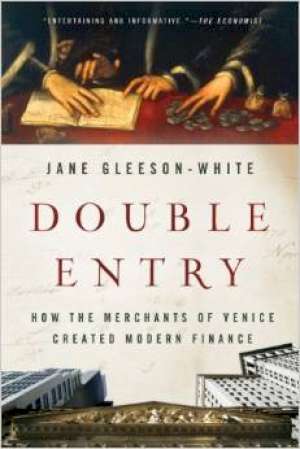12 October 2014
Double Entry
How the Merchants of Venice created Modern Finance
Jane Gleeson-White
2013, Allen & Unwin, 304 pages, £8.99
ISBN 9780393346596
Reviewer: Rosemary Connell

This is a compelling, well-researched history of accounting, its successes and failures. The author describes the course of accounting from the earliest Mesopotamian tokens of 7000 BC; the first use of coinage in classical Greece and Rome; merchants using cheques and rudimentary double-entry book-keeping in the 1300s; and the fascinating history of mathematics.
The father of double-entry bookkeeping was a Franciscan monk, Luca Pacioli, who published a treatise on Venetian bookkeeping in 1494. It is a 27-page section of his vast Summa de Arithmetica, Geometrica, Portiona et Proportionali called “Particularis de computis et scriptus.” This tract is the source of modern accounting. Venice had become the printing capital of Southern Europe, so it was widely read. The author details Pacoioli’s interesting life story, including his collaboration with Leonardo da Vinci.
With the decline of Venice as a commercial power, Antwerp became a centre of international trade, and Dutch writers like Stevin produced subsequent innovations in bookkeeping. The earliest work on double entry in England was by Oldcastle in 1543. Still, all bookkeeping treatises written between 1500 and 1800 can be traced back to Pacioli.
Then a challenge came from Britain – “Jones’ English system” – which failed. The Industrial Revolution propelled new forays into accounting. Josiah Wedgwood discovered the importance of distinguishing between fixed and variable cost. The accounting profession came into being as did increased regulation of companies following a series of financial crises.
Keynes’s General Theory provided a theoretical basis for the measurement of national income, consumption, investment and savings, and the subsequent national accounts used the principles of double entry book-keeping to construct his whole-economy framework. Debate continues about the usefulness of national income measures.
The collapse of Enron was followed by numerous corporate accounting scandals and then the crisis of 2008. Accounting practices can obscure true financial positions and computers and electronics make the audit trail even trickier to follow – examples are provided and failures noted in the book. Corporations often do not pay for the true cost of their activities which should include environmental and social costs – GDP is a flawed guide to a nation’s well-being as it is not intended to take account of the costs of economic growth. The conclusion here is that the book-keeping approach should not be used as the primary measure of the health of companies or nations.
This book will have wide appeal to diverse audiences including historians, economists, accountants and businessmen.
